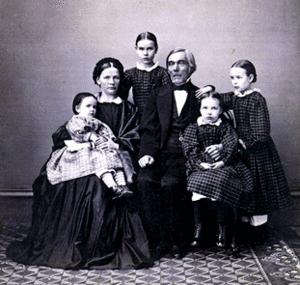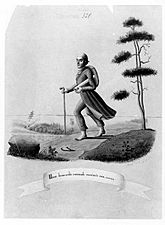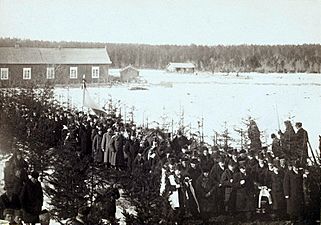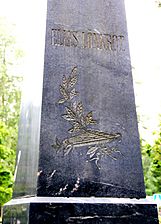Elias Lönnrot facts for kids
Quick facts for kids
Elias Lönnrot
|
|
|---|---|
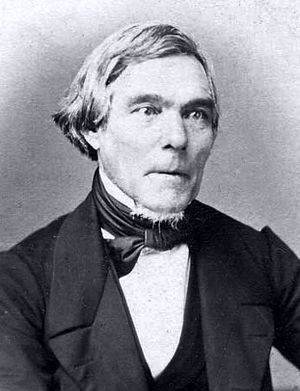 |
|
| Born | 9 April 1802 Sammatti, Nyland and Tavastehus County, Sweden
|
| Died | 19 March 1884 (aged 81) Sammatti, Uusimaa, Grand Principality of Finland
|
| Nationality | Finnish |
| Occupation | physician, philologist, poetry collector |
|
Notable work
|
Kalevala, Kanteletar |
Elias Lönnrot (Finnish: [ˈeliɑs ˈlønruːt]; 9 April 1802 – 19 March 1884) was a famous Finnish doctor. He was also a philologist, which means he studied languages and old texts. Lönnrot is best known for collecting traditional Finnish poems and stories. He used these to create Finland's national epic, the Kalevala. He gathered these stories during many trips across Finland and nearby areas.
Contents
Learning and Early Life
Elias Lönnrot was born in Sammatti, Finland, in 1802. At that time, Finland was part of Sweden. He decided to study medicine at the Academy of Åbo (now Turku). During his first year, a huge fire destroyed the university.
Because of the fire, the university moved to Helsinki. Helsinki was becoming the new capital of Finland. Lönnrot moved with the university and finished his studies in 1832.
His Work as a Doctor
Lönnrot became a district doctor in Kajaani, Eastern Finland. This was a very difficult time. There was a famine, meaning people didn't have enough food. There were also many illnesses spreading. The previous doctor had left because of these hard conditions.
Lönnrot was the only doctor for about 4,000 people. Most of them lived in small villages far apart. Hospitals and modern medicines were very expensive back then. So, most people relied on local healers and old remedies. Lönnrot was interested in these traditional cures himself. He also strongly believed that good hygiene and vaccines could prevent many diseases.
His Language Work
Lönnrot started writing about the Finnish language in 1827. Around the same time, he began collecting folk tales from people in the countryside. In 1831, the Finnish Literature Society was started. Lönnrot was one of its founders. The society gave him money to help with his collecting trips.
He took many breaks from his doctor's job to travel. He explored the Finnish countryside, Lapland, and parts of Russian Karelia. These trips led to several important books:
- Kantele (1829–1831), named after a Finnish musical instrument.
- Kalevala (1835–1836), the first version of the famous epic.
- Kanteletar (1840), a collection of lyric poems.
- Sananlaskuja (1842), a book of proverbs.
- An even bigger version of Kalevala (1849), known as the "new" Kalevala.
Because of his amazing work in saving Finland's oral traditions, Lönnrot became a professor. In 1853, he was given the Chair of Finnish Literature at the University of Helsinki.
He also worked on the first big Finnish-Swedish dictionary. This dictionary, Finsk-Svenskt lexikon, was published between 1866 and 1880. It had over 200,000 words! Lönnrot even invented many of the Finnish words himself. His deep knowledge of old Finnish poetry made him an expert. Many of the words he created are still used today. For example, in Finnish, words for "grammar" (kielioppi) and "literature" (kirjallisuus) were coined by him.
Work in Botany
Lönnrot was also interested in plants. In 1860, he wrote the first book about Finnish plants in the Finnish language. It was called Flora Fennica – Suomen Kasvisto. This book became very famous in Scandinavia. It was one of the first science books written in a common language, not just Latin.
A second, larger version of the book came out in 1866. It was written with Th. Saelan. Lönnrot's Flora Fennica also included notes on how people used different plants.
His Lasting Impact
Elias Lönnrot's work had a huge impact.
- The Finnish artist Erik Bruun put Lönnrot's picture on the 500 markka banknote.
- The coat of arms for Sammatti, Lönnrot's hometown, has a maple leaf. This is because lönn means 'maple' in Swedish.
- The famous comic book artist Don Rosa included Lönnrot in his story "The Quest for Kalevala", featuring Scrooge McDuck and Donald Duck.
- The writer Jorge Luis Borges named a detective character "Lönnrot" in his story Death and the Compass.
- The Kalevala, which Lönnrot put together, inspired J. R. R. Tolkien. Tolkien used it when writing his famous books, The Silmarillion and The Lord of the Rings.
- In 2002, Finland made a special coin to honor Elias Lönnrot and Finnish folklore.
- An asteroid in space, 2243 Lönnrot, is named after him.
- Ellen Kushner's fantasy story 'The Threefold World' also features Elias Lönnrot as the main character.
Gallery
-
Lönnrot and the Oral Poets, Akseli Gallen-Kallela, 1895
See also
 In Spanish: Elias Lönnrot para niños
In Spanish: Elias Lönnrot para niños
- Day of the Finnish Language



